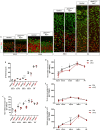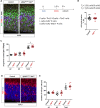Ephrin-B2 paces neuronal production in the developing neocortex
- PMID: 32404061
- PMCID: PMC7222552
- DOI: 10.1186/s12861-020-00215-3
Ephrin-B2 paces neuronal production in the developing neocortex
Abstract
Background: During mammalian cerebral cortex development, different types of projection neurons are produced in a precise temporal order and in stereotypical numbers. The mechanisms regulating timely generation of neocortex projection neurons and ensuring production in sufficient numbers of each neuronal identity are only partially understood.
Results: Here, we show that ephrin-B2, a member of the Eph:ephrin cell-to-cell communication pathway, sets the neurogenic tempo in the neocortex. Indeed, conditional mutant embryos for ephrin-B2 exhibit a transient delay in neurogenesis and acute stimulation of Eph signaling by in utero injection of synthetic ephrin-B2 led to a transient increase in neuronal production. Using genetic approaches we show that ephrin-B2 acts on neural progenitors to control their differentiation in a juxtacrine manner. Unexpectedly, we observed that perinatal neuron numbers recovered following both loss and gain of ephrin-B2, highlighting the ability of neural progenitors to adapt their behavior to the state of the system in order to produce stereotypical numbers of neurons.
Conclusions: Altogether, our data uncover a role for ephrin-B2 in embryonic neurogenesis and emphasize the plasticity of neuronal production in the neocortex.
Keywords: Eph:ephrin signaling; Mouse; Neocortex; Neural progenitors; Neurogenesis.
Conflict of interest statement
The authors declare that they have no competing interests.
Figures





Similar articles
-
Ephrin B1 is expressed on neuroepithelial cells in correlation with neocortical neurogenesis.J Neurosci. 2001 Apr 15;21(8):2726-37. doi: 10.1523/JNEUROSCI.21-08-02726.2001. J Neurosci. 2001. PMID: 11306625 Free PMC article.
-
Ephrin-B2/EphA4 forward signaling is required for regulation of radial migration of cortical neurons in the mouse.Neurosci Bull. 2014 Jun;30(3):425-32. doi: 10.1007/s12264-013-1404-1. Epub 2014 Jan 29. Neurosci Bull. 2014. PMID: 24477991 Free PMC article.
-
Astrocytes regulate adult hippocampal neurogenesis through ephrin-B signaling.Nat Neurosci. 2012 Oct;15(10):1399-406. doi: 10.1038/nn.3212. Epub 2012 Sep 16. Nat Neurosci. 2012. PMID: 22983209 Free PMC article.
-
Neocortical neurogenesis: morphogenetic gradients and beyond.Trends Neurosci. 2009 Aug;32(8):443-50. doi: 10.1016/j.tins.2009.05.003. Epub 2009 Jul 25. Trends Neurosci. 2009. PMID: 19635637 Free PMC article. Review.
-
Neural progenitors, neurogenesis and the evolution of the neocortex.Development. 2014 Jun;141(11):2182-94. doi: 10.1242/dev.090571. Development. 2014. PMID: 24866113 Review.
Cited by
-
De novo monoallelic Reelin missense variants cause dominant neuronal migration disorders via a dominant-negative mechanism.J Clin Invest. 2024 Jul 9;134(16):e153097. doi: 10.1172/JCI153097. J Clin Invest. 2024. PMID: 38980724 Free PMC article.
-
Population Dynamics and Neuronal Polyploidy in the Developing Neocortex.Cereb Cortex Commun. 2020 Sep 7;1(1):tgaa063. doi: 10.1093/texcom/tgaa063. eCollection 2020. Cereb Cortex Commun. 2020. PMID: 34296126 Free PMC article.
References
-
- Malatesta P, Hartfuss E, Gotz M. Isolation of radial glial cells by fluorescent-activated cell sorting reveals a neuronal lineage. Development. 2000;127(24):5253–5263. - PubMed
Publication types
MeSH terms
Substances
Grants and funding
LinkOut - more resources
Full Text Sources
Molecular Biology Databases
Miscellaneous

